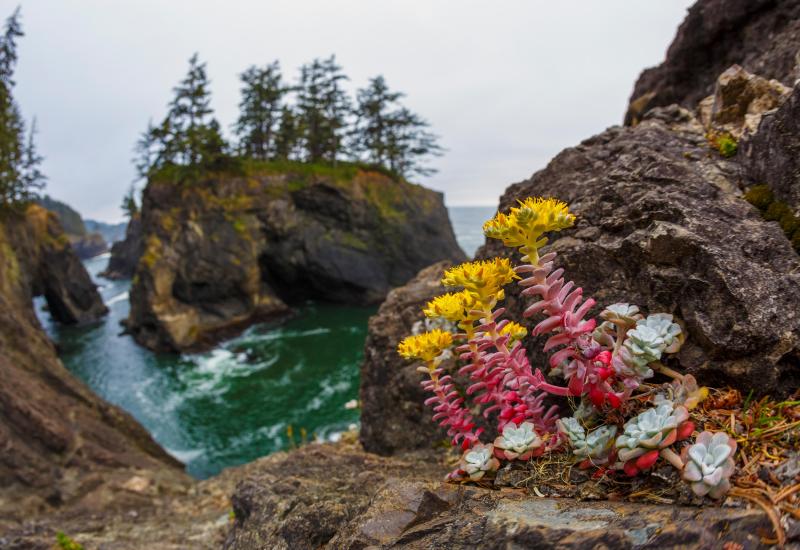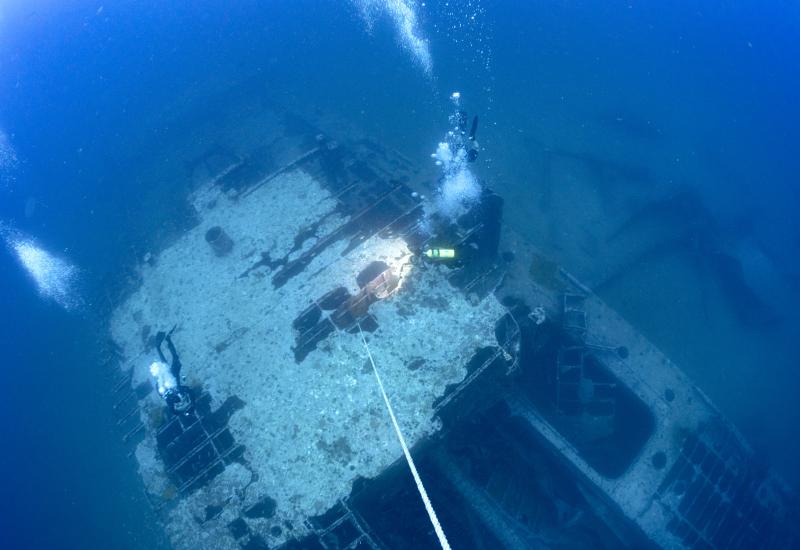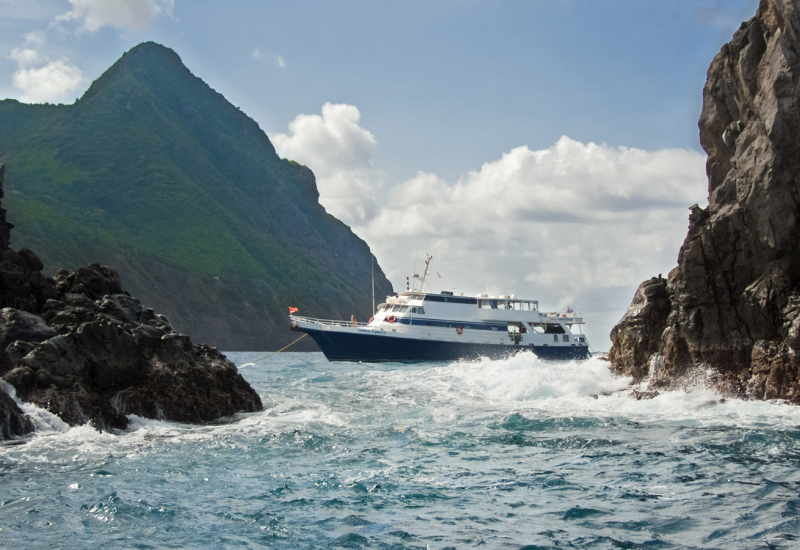Encounters: Eight-Legged Freaks!
Due to their keen camouflage tricks and seeming ability to outsmart us, octopuses fascinate divers. The hunt is only the beginning: We scan reef and rubble for tentacles and shell piles, occasionally rewarded with an opportunity to discover this animal’s reactions. Will we be deceived, or do we give octopuses too much credit? After all, points out Dr. Roland Anderson, a retired Seattle Aquarium biologist, “How smart can a cousin of the clam be?”
FIVE OCTO FACTS
1 Giant Pacific octopuses, which grow to eight feet in length and weigh 100 pounds, can wiggle their bodies through a baseball-size opening.
2 Octopuses can be trained visually to run mazes, even making detours when a new food source appears.
3 Every inch of an octopus’ skin tastes what it touches.
4 Octopuses quickly learn to recognize individuals. At the New England Aquarium, a giant Pacific octopus named Truman took a dislike to a female volunteer, using his siphon to squirt a stream of water at her each time she entered the room.
5 Germans rallied behind Paul the Octopus each time he predicted a win for the national team during the 2010 FIFA World Cup, but when he chose Spain as the victors, livid fans hungered for sushi justice.

Mark Laita
Giant Pacific Octopus
Puget Sound, Washington
A much-shared YouTube clip proves the giant Pacific octopus’ death grip: First it robs Victor Huang of his video camera, trading it for his spear gun before finally retreating. The power of the world’s largest octopus species is indisputable. Them largest scientist-recorded Enteroctopus dofleini weighed approximately 150 pounds and measured 20 feet across, arm tip to arm tip. Anderson suggests sticking to depths between 40 and 90 feet and looking for the rubble pile, also called a midden, of discarded Dungeness and red rock-crab shells. The species is crepuscular, so dive at dawn or dusk. If you’re feeling daring, Anderson suggests offering a crab or scuttling a bit with your fingers in front of the den to arouse its curiosity. Divers will be able to find the species throughout Puget Sound. One of the easiest sites, reachable from shore, is Elliott Bay near the Seattle Aquarium. Hood Canal is another wildly popular area for prolific sightings. Photographers have even captured images of females guarding hundreds of thousands of eggs.
>WHEN TO GO Winter is the best season for giant Pacific octopus due to better visibility.
>OPERATORS Pacific Adventure Dive Charters (pacadventure.com), based in the Pleasant Harbor Marina in Brinnon, Washington — a 90-minute drive from Olympia — offers charters aboard its 38-foot-long, heavily modified dive boat to sites in Hood Canal, such as Black Point and Rosie’s Ravine. Post-dive, you can warm up with a hot shower aboard the boat.
>PRICE TAG Two-tank dive trips cost $80, and include snacks, hot beverages and soup.

Debi Henshaw
Blue-Ring Octopus
Heron Island, Australia
Few animals have the ability to flash neon lights; the blue-ringed octopus does when it’s angry. The peacock-blue circles that distinguish these four species also defend them, serving as a warning to potential predators who mistake the marks as eyes.Perhaps the deadliest critter in the sea, the blue-ring packs a neurotoxin punch “far more poisonous than cyanide,” warns Dr. Lydia Mathger, who has been studying mollusks for 12 years. The venom, which “can easily kill 30 people,” is spread through a bite or a rub against the skin. There is no antidote. The octopus’ Herculean defense enables the blue-ring to enjoy a relatively leisurely lifestyle. The species rarely dashes out of shells and other hiding places, making it hard to spot. Mathger recommends heading to the shallows to find them: Overturn shells and peer into crevices. Most important, remember that thick neoprene gloves are a must.
>WHEN TO GO Year-round
>OPERATORS The Heron Island Marine Center at Heron Island Resort (heronisland.com) offers daily, guided dive trips from three fully equipped dive boats.
>PRICE TAG Boat dives cost $66. A three night, dive-inclusive stay starts at $497 per night, and includes five dives a day and three meals a day for two people.

Wikimedia Commons/Bernd
**Mimic Octopus
**Lembeh Strait
The mimic octopus is a living, breathing Rorschach inkblot test: The chameleon contorts into 13 different body positions resembling other species, but we assign the meaning, finding shapes such as flounder and sponges. “Mimicry is one of the slipperiest subjects in science,” says Dr. Roger Hanlon, an expert in animal camouflage who prefers to call the phenomenon “deceptive resemblance.” To find these creative contortionists, hire a guide. Local experts such as Serge Abourjeily at NAD-Lembeh Resort know what to look for at sites like Rojos, Aer Bajo and Hairball. For starters, the octopus is found exclusively in the black-sand environment in depths ranging from six to 75 feet. The mimic is most commonly sighted in an “up-periscope” position with its head raised high above its body. Abourjeily stresses a slow approach. Stay still to study the odd behavior of this day-active species. One such move: They disappear for up to five minutes into the muck. “We don’t know how they breathe in the sand,” Hanlon says. The mollusk’s ability to appear like a flounder impresses Hanlon the most. The mimic changes its position, rate of undulation and even the direction it typically swims. Why? Only large predators eat flounder, whereas a host of small critters will try to nip off a bit of tentacle. Apparently, shape-shifting has benefits.
>WHEN TO GO Year-round
>OPERATORS NAD-Lembeh Diving Resort (nad-lembeh.com) is a small resort with several highly experienced guides.
>PRICE TAG A seven-night, 17-dive package costs $876 in an air-conditioned room

James Scott
**Caribbean Reef Octopus
**Bonaire
The Caribbean reef octopus is among the most civilized cephalopods. Six species — including the Caribbean ocellate and long-armed octopuses — call Bonaire home, but it’s unlikely two species will be seen on the same dive thanks to their capacity to share. “They don’t overlap in time or space,” says Anderson. These time-share experts have divvied up hunting hours: Octopus briareus has dibs on the night — the darker the better. For best odds of encountering one, enter the water at or after midnight. Fin to sea-grass beds where the predator stalks crabs and slipper lobsters. Another tactic? Look for their dens. Besides the telltale pile of bivalves — this species is a glutton for anything on the half shell— Anderson advises to scout for smooth stones. Often a pile of golf-ball-size, algae- free rocks, used to barricade the entryway, mark an octopad. John Wall, director of Buddy Dive Resort’s photo center, suggests starting with Buddy’s house reef, home to three or four octopuses at any given time. His other hot spots include Salt Pier and along the reef’s edge at Something Special.
>WHEN TO GO Year-round
>OPERATORS Buddy Dive (buddydive.com) specializes in round-the-clock diving. Driveup tank fills and truck rentals let you set the schedule. Plaza Resort (plazaresortbonaire.com) also offers vehicle rental with its packages, which also include all meals.
>PRICE TAG A drive-and-dive seven-night package starts at $1,060, and includes unlimited shore diving, vehicle rental, daily breakfast and six boat dives per person. Plaza Resort’s weekly rates start at $1,250 per person based on double occupancy.
Due to their keen camouflage tricks and seeming ability to outsmart us, octopuses fascinate divers. The hunt is only the beginning: We scan reef and rubble for tentacles and shell piles, occasionally rewarded with an opportunity to discover this animal’s reactions. Will we be deceived, or do we give octopuses too much credit? After all, points out Dr. Roland Anderson, a retired Seattle Aquarium biologist, “How smart can a cousin of the clam be?”
FIVE OCTO FACTS
1 Giant Pacific octopuses, which grow to eight feet in length and weigh 100 pounds, can wiggle their bodies through a baseball-size opening.
2 Octopuses can be trained visually to run mazes, even making detours when a new food source appears.
3 Every inch of an octopus’ skin tastes what it touches.
4 Octopuses quickly learn to recognize individuals. At the New England Aquarium, a giant Pacific octopus named Truman took a dislike to a female volunteer, using his siphon to squirt a stream of water at her each time she entered the room.
5 Germans rallied behind Paul the Octopus each time he predicted a win for the national team during the 2010 FIFA World Cup, but when he chose Spain as the victors, livid fans hungered for sushi justice.










